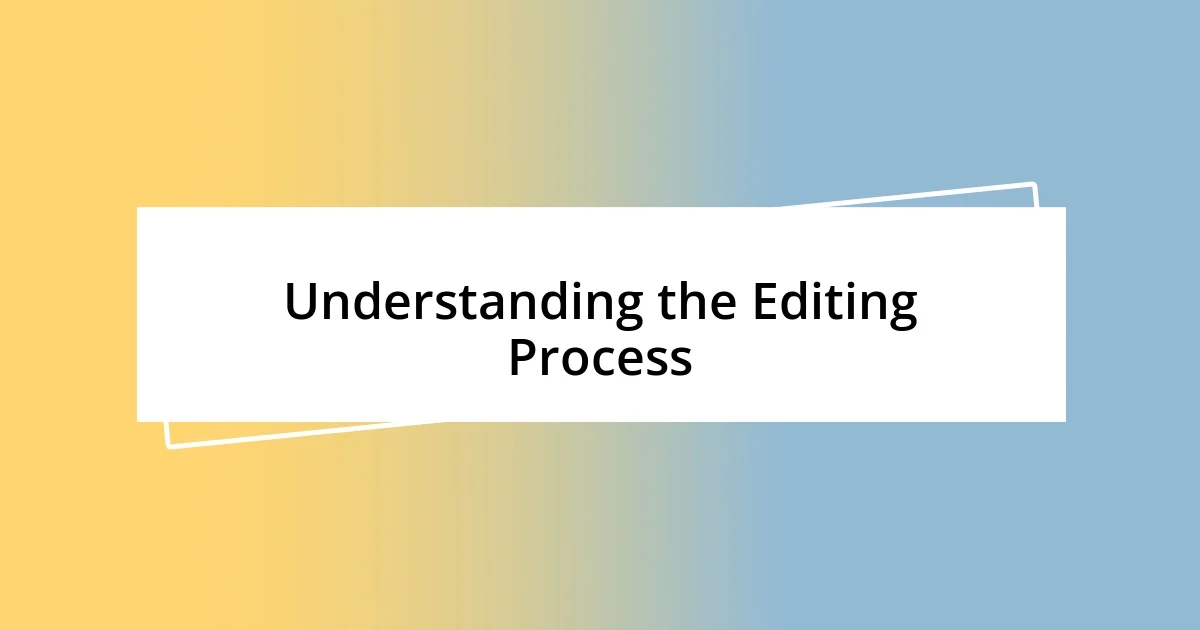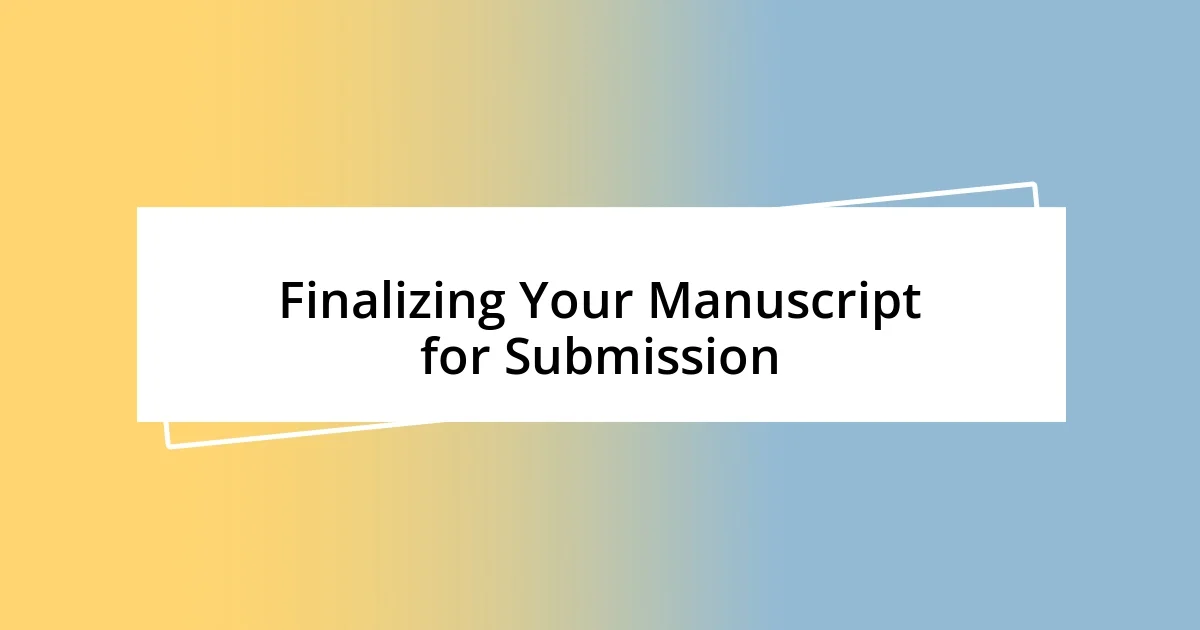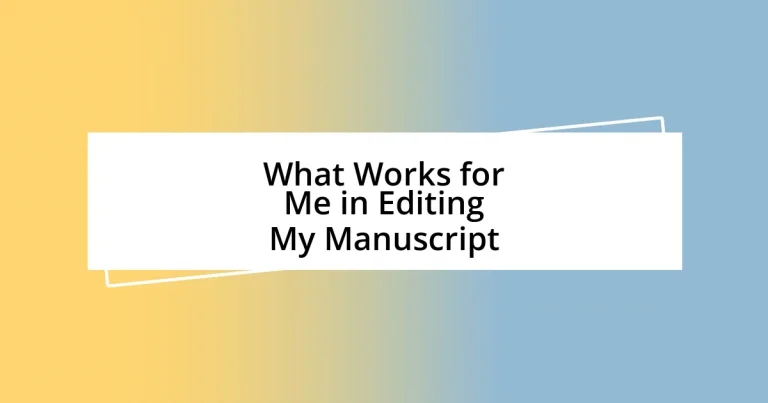Key takeaways:
- Editing is a multi-layered process that goes beyond correcting errors; it involves emotional connection to characters and themes, and openness to making significant changes for clarity and resonance.
- Setting clear editing goals and creating a revision timeline can make the editing process more structured and manageable, providing focus and motivation throughout the revisions.
- Utilizing techniques like reading aloud, reverse outlining, and seeking feedback from genre-appropriate peers can significantly enhance the quality of a manuscript and improve the overall editing experience.

Understanding the Editing Process
Editing is often misunderstood, with many thinking it’s just about correcting typos or grammatical errors. I remember the first time I tackled a major manuscript; I realized that editing is much deeper. It’s like peeling layers of an onion—each layer removed reveals more substance and clarity.
As I edit, I lean into the emotional journey of my characters and themes. I ask myself, “Does this scene evoke the feelings I want it to?” It’s a thoughtful process that can be both exhilarating and exhausting. Sometimes, I find myself questioning entire chapters because I feel they don’t truly resonate—this self-reflection is crucial to creating a manuscript that speaks to readers.
Ultimately, understanding the editing process means being open to change. I often remind myself that cutting a passage doesn’t mean it wasn’t worthwhile; rather, it emphasizes my commitment to crafting a polished, cohesive story. Have you ever felt attached to your words, only to realize that the story shines brighter without them? Embracing those moments can lead to incredible breakthroughs in your writing.

Setting Clear Editing Goals
Setting clear editing goals can transform the editing process from a daunting task into a manageable journey. I remember the first time I set specific goals for editing; it turned the chaos of revisions into a structured plan. Instead of sitting down with a vague sense of what to fix, I created a checklist that helped me focus on specific aspects of my manuscript.
Here are some of the goals I find valuable when editing:
- Identify and eliminate filler words to enhance clarity.
- Ensure character arcs are compelling and believable.
- Revisit dialogue to ensure it sounds natural and authentic.
- Check for consistency in tone and voice throughout the manuscript.
- Create a timeline for completing each round of edits to stay organized.
Setting these goals gives me not just clarity, but also motivation to push through the tougher parts of the edit. It’s a bit like having a roadmap; I know exactly where I’m going and can appreciate the journey along the way.

Utilizing Editing Techniques Effectively
Utilizing various editing techniques can significantly enhance the quality of your manuscript. One approach I find particularly effective is reading my work aloud. This technique allows me to hear how the words flow and spot awkward phrases I might have glossed over while reading silently. I remember the first time I did this and was astounded to discover how differently the text sounded. It’s like giving my writing a voice—one that often reveals its strengths and weaknesses in a completely new light.
Another technique I’ve integrated into my editing process is the “reverse outline.” By going back through my manuscript and summarizing each section in a few words, I can assess the overall structure and ensure each part contributes to the storyline. I can’t stress enough how this technique helped me identify sections that felt lackluster or off-topic. It’s a kind of map, showing me whether my journey is cohesive and engaging for readers.
Finally, I utilize feedback from trusted beta readers. Their perspectives often highlight areas I hadn’t noticed, turning my manuscript into a conversation rather than a solitary endeavor. I’ve learned that sometimes, stepping back and allowing others to weigh in can breathe new life into my work. I genuinely love when a reader points out a plot twist I thought was subtle but, in reality, needed more clarity. Their insights can spark new ideas that elevate the manuscript to a whole new level.
| Editing Technique | Description |
|---|---|
| Reading Aloud | This helps uncover awkward phrasing and unintentional repetition by hearing the text. |
| Reverse Outlining | Summarizing each section helps clarify the manuscript’s structure and ensure coherence. |
| Beta Reader Feedback | Invaluable perspectives from others can highlight strengths and weaknesses, enriching the editing process. |

Creating a Revision Timeline
Creating a revision timeline is an essential step that I’ve found to keep my editing process on track. When I first started writing, I often felt overwhelmed by the sheer volume of revisions I needed to make. By laying out a timeline that breaks down each round of edits, I transformed chaos into a series of manageable tasks. I typically allocate specific weeks for each editing phase, allowing time for fresh eyes on my work, which I believe is crucial for evaluating my manuscript with clarity.
One technique that has worked for me is mapping out milestone deadlines along the way. For example, I sometimes set a goal to complete my initial read-through by a certain date and then allow a week for reflecting on feedback from beta readers. This approach keeps my momentum alive. I vividly remember the rush of satisfaction I felt the first time I completed a timeline and met each deadline; it felt less like work and more like I was guiding my manuscript on a journey.
While sticking to a timeline can be challenging, I’ve discovered the importance of flexibility. Life happens! I can’t tell you how many times I aimed to finish a round of edits in two weeks, only to realize that a particular section needed extra attention. Rather than growing frustrated, I learned to adapt my timeline, giving myself grace and understanding that revisions are often a nuanced process. Embracing this fluidity not only helps in maintaining my creative energy but also makes the entire editing experience feel less daunting and more rewarding.

Seeking Feedback from Peers
When I think about seeking feedback from peers, I realize how crucial their insights can be. I remember the first time I shared my manuscript with a group of fellow writers. Their fresh perspectives exposed flaws I was blind to, and their praise helped me understand what truly resonated with readers. It’s surprising how much clarity others can bring, don’t you think? Sometimes, all it takes is one person’s comment to spark a revelation, turning my work from good to great.
I’ve also learned to approach feedback with an open mind. Initially, I felt defensive when critique arrived—I mean, who wouldn’t? But over time, I came to appreciate the feedback for what it truly is: a gift. I recall a peer suggesting a more dramatic twist in my story; at first, I hesitated, but I couldn’t deny the excitement it brought. Embracing their feedback helped me see my writing as a collaborative process, not just a solitary endeavor. It transformed the way I view constructive criticism altogether.
Finally, I have a go-to rule that I find helpful: always seek feedback from those who understand your genre. Each time I’ve shared my work with writers outside my niche, I found their feedback often leads me astray. For instance, I once partnered with a fantasy writer while working on a contemporary story, and the advice felt off-base—like trying to fit a square peg in a round hole. It underscored the importance of choosing the right peers for feedback that truly aligns with my vision. Isn’t it fascinating how the right voices can enhance our work drastically?

Tools to Enhance Your Editing
There’s a wealth of editing tools out there that can truly elevate the process—both digital and more traditional. I’ve found that software like Grammarly and ProWritingAid not only help catch grammatical errors, but they also enhance my overall writing style. The first time I used Grammarly, I was surprised to see how many nuances I had missed. It felt like having a knowledgeable writing partner who never gets tired of offering advice.
Just as essential are the more analog tools, like a simple notebook to jot down recurring issues in my writing. This strategy has helped me identify patterns over time, such as my tendency to rely too heavily on passive voice. It’s a bit like having a mini-debrief with myself after each manuscript. I usually flip through my notes before starting edits; it’s a grounding ritual that reminds me of my growth as a writer. Have you ever kept a journal for your writing? I highly recommend it—it’s enlightening.
To keep my editing process organized, I’ve also started using Trello boards to manage different rounds of edits and to showcase feedback from peers. This visual approach allows me to track everything in one place, and, honestly, it’s a joy to move cards from one column to another, signifying progress! I remember feeling a rush of accomplishment after a particularly intense editing session, watching those cards climb from “In Progress” to “Completed.” It reinforced my belief that the right tools can make all the difference, don’t you think?

Finalizing Your Manuscript for Submission
Finalizing your manuscript for submission often feels like a monumental task, but it’s one of the most rewarding parts of the writing journey. I remember the thrill I felt when I typed my last words, yet there was still this nagging voice reminding me to take a step back. It’s essential to let your manuscript breathe before diving into final edits. Giving myself that little time away helped me return with fresh eyes, ready to catch those sneaky errors I overlooked during the first pass.
One practice that I find invaluable is reading my manuscript aloud. Sounds simple, right? But each time I do, the rhythm of my writing reveals itself in ways I hadn’t expected. I vividly recall the moment I stammered through a particularly clunky sentence; it became painfully clear that it needed work. It’s fascinating how our voices can help shape the flow of our words. Have you tried this method? You might be surprised by what you hear!
Finally, I can’t stress enough the importance of double-checking your submission guidelines. There was that one time I almost submitted my work in the wrong format—imagine my panic! From font type to word count, each detail matters. Submitting correctly not only reflects professionalism, but it also ensures your hard work gets the attention it deserves. It’s like dressing your manuscript in its Sunday best—don’t you think it deserves that final touch?














